Input interpretation

H_2 hydrogen + HgO mercuric oxide ⟶ H_2O water + Hg mercury
Balanced equation
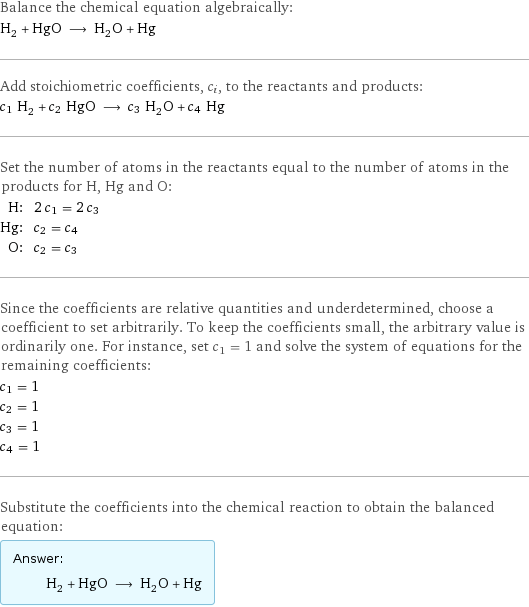
Balance the chemical equation algebraically: H_2 + HgO ⟶ H_2O + Hg Add stoichiometric coefficients, c_i, to the reactants and products: c_1 H_2 + c_2 HgO ⟶ c_3 H_2O + c_4 Hg Set the number of atoms in the reactants equal to the number of atoms in the products for H, Hg and O: H: | 2 c_1 = 2 c_3 Hg: | c_2 = c_4 O: | c_2 = c_3 Since the coefficients are relative quantities and underdetermined, choose a coefficient to set arbitrarily. To keep the coefficients small, the arbitrary value is ordinarily one. For instance, set c_1 = 1 and solve the system of equations for the remaining coefficients: c_1 = 1 c_2 = 1 c_3 = 1 c_4 = 1 Substitute the coefficients into the chemical reaction to obtain the balanced equation: Answer: | | H_2 + HgO ⟶ H_2O + Hg
Structures

+ ⟶ +
Names

hydrogen + mercuric oxide ⟶ water + mercury
Reaction thermodynamics
Enthalpy
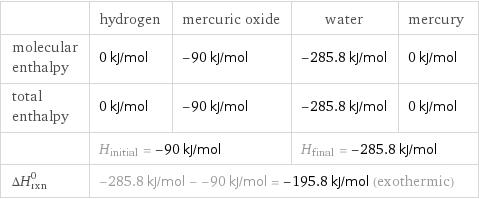
| hydrogen | mercuric oxide | water | mercury molecular enthalpy | 0 kJ/mol | -90 kJ/mol | -285.8 kJ/mol | 0 kJ/mol total enthalpy | 0 kJ/mol | -90 kJ/mol | -285.8 kJ/mol | 0 kJ/mol | H_initial = -90 kJ/mol | | H_final = -285.8 kJ/mol | ΔH_rxn^0 | -285.8 kJ/mol - -90 kJ/mol = -195.8 kJ/mol (exothermic) | | |
Gibbs free energy
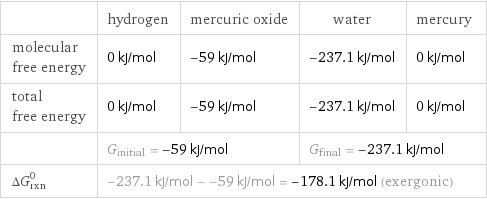
| hydrogen | mercuric oxide | water | mercury molecular free energy | 0 kJ/mol | -59 kJ/mol | -237.1 kJ/mol | 0 kJ/mol total free energy | 0 kJ/mol | -59 kJ/mol | -237.1 kJ/mol | 0 kJ/mol | G_initial = -59 kJ/mol | | G_final = -237.1 kJ/mol | ΔG_rxn^0 | -237.1 kJ/mol - -59 kJ/mol = -178.1 kJ/mol (exergonic) | | |
Entropy
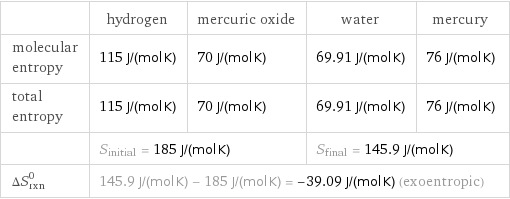
| hydrogen | mercuric oxide | water | mercury molecular entropy | 115 J/(mol K) | 70 J/(mol K) | 69.91 J/(mol K) | 76 J/(mol K) total entropy | 115 J/(mol K) | 70 J/(mol K) | 69.91 J/(mol K) | 76 J/(mol K) | S_initial = 185 J/(mol K) | | S_final = 145.9 J/(mol K) | ΔS_rxn^0 | 145.9 J/(mol K) - 185 J/(mol K) = -39.09 J/(mol K) (exoentropic) | | |
Equilibrium constant
![Construct the equilibrium constant, K, expression for: H_2 + HgO ⟶ H_2O + Hg Plan: • Balance the chemical equation. • Determine the stoichiometric numbers. • Assemble the activity expression for each chemical species. • Use the activity expressions to build the equilibrium constant expression. Write the balanced chemical equation: H_2 + HgO ⟶ H_2O + Hg Assign stoichiometric numbers, ν_i, using the stoichiometric coefficients, c_i, from the balanced chemical equation in the following manner: ν_i = -c_i for reactants and ν_i = c_i for products: chemical species | c_i | ν_i H_2 | 1 | -1 HgO | 1 | -1 H_2O | 1 | 1 Hg | 1 | 1 Assemble the activity expressions accounting for the state of matter and ν_i: chemical species | c_i | ν_i | activity expression H_2 | 1 | -1 | ([H2])^(-1) HgO | 1 | -1 | ([HgO])^(-1) H_2O | 1 | 1 | [H2O] Hg | 1 | 1 | [Hg] The equilibrium constant symbol in the concentration basis is: K_c Mulitply the activity expressions to arrive at the K_c expression: Answer: | | K_c = ([H2])^(-1) ([HgO])^(-1) [H2O] [Hg] = ([H2O] [Hg])/([H2] [HgO])](../image_source/df6699b385be51bec3c187490d51b61a.png)
Construct the equilibrium constant, K, expression for: H_2 + HgO ⟶ H_2O + Hg Plan: • Balance the chemical equation. • Determine the stoichiometric numbers. • Assemble the activity expression for each chemical species. • Use the activity expressions to build the equilibrium constant expression. Write the balanced chemical equation: H_2 + HgO ⟶ H_2O + Hg Assign stoichiometric numbers, ν_i, using the stoichiometric coefficients, c_i, from the balanced chemical equation in the following manner: ν_i = -c_i for reactants and ν_i = c_i for products: chemical species | c_i | ν_i H_2 | 1 | -1 HgO | 1 | -1 H_2O | 1 | 1 Hg | 1 | 1 Assemble the activity expressions accounting for the state of matter and ν_i: chemical species | c_i | ν_i | activity expression H_2 | 1 | -1 | ([H2])^(-1) HgO | 1 | -1 | ([HgO])^(-1) H_2O | 1 | 1 | [H2O] Hg | 1 | 1 | [Hg] The equilibrium constant symbol in the concentration basis is: K_c Mulitply the activity expressions to arrive at the K_c expression: Answer: | | K_c = ([H2])^(-1) ([HgO])^(-1) [H2O] [Hg] = ([H2O] [Hg])/([H2] [HgO])
Rate of reaction
![Construct the rate of reaction expression for: H_2 + HgO ⟶ H_2O + Hg Plan: • Balance the chemical equation. • Determine the stoichiometric numbers. • Assemble the rate term for each chemical species. • Write the rate of reaction expression. Write the balanced chemical equation: H_2 + HgO ⟶ H_2O + Hg Assign stoichiometric numbers, ν_i, using the stoichiometric coefficients, c_i, from the balanced chemical equation in the following manner: ν_i = -c_i for reactants and ν_i = c_i for products: chemical species | c_i | ν_i H_2 | 1 | -1 HgO | 1 | -1 H_2O | 1 | 1 Hg | 1 | 1 The rate term for each chemical species, B_i, is 1/ν_i(Δ[B_i])/(Δt) where [B_i] is the amount concentration and t is time: chemical species | c_i | ν_i | rate term H_2 | 1 | -1 | -(Δ[H2])/(Δt) HgO | 1 | -1 | -(Δ[HgO])/(Δt) H_2O | 1 | 1 | (Δ[H2O])/(Δt) Hg | 1 | 1 | (Δ[Hg])/(Δt) (for infinitesimal rate of change, replace Δ with d) Set the rate terms equal to each other to arrive at the rate expression: Answer: | | rate = -(Δ[H2])/(Δt) = -(Δ[HgO])/(Δt) = (Δ[H2O])/(Δt) = (Δ[Hg])/(Δt) (assuming constant volume and no accumulation of intermediates or side products)](../image_source/7fa70a1ad9c90b099aa7e0ed07a64a41.png)
Construct the rate of reaction expression for: H_2 + HgO ⟶ H_2O + Hg Plan: • Balance the chemical equation. • Determine the stoichiometric numbers. • Assemble the rate term for each chemical species. • Write the rate of reaction expression. Write the balanced chemical equation: H_2 + HgO ⟶ H_2O + Hg Assign stoichiometric numbers, ν_i, using the stoichiometric coefficients, c_i, from the balanced chemical equation in the following manner: ν_i = -c_i for reactants and ν_i = c_i for products: chemical species | c_i | ν_i H_2 | 1 | -1 HgO | 1 | -1 H_2O | 1 | 1 Hg | 1 | 1 The rate term for each chemical species, B_i, is 1/ν_i(Δ[B_i])/(Δt) where [B_i] is the amount concentration and t is time: chemical species | c_i | ν_i | rate term H_2 | 1 | -1 | -(Δ[H2])/(Δt) HgO | 1 | -1 | -(Δ[HgO])/(Δt) H_2O | 1 | 1 | (Δ[H2O])/(Δt) Hg | 1 | 1 | (Δ[Hg])/(Δt) (for infinitesimal rate of change, replace Δ with d) Set the rate terms equal to each other to arrive at the rate expression: Answer: | | rate = -(Δ[H2])/(Δt) = -(Δ[HgO])/(Δt) = (Δ[H2O])/(Δt) = (Δ[Hg])/(Δt) (assuming constant volume and no accumulation of intermediates or side products)
Chemical names and formulas

| hydrogen | mercuric oxide | water | mercury formula | H_2 | HgO | H_2O | Hg name | hydrogen | mercuric oxide | water | mercury IUPAC name | molecular hydrogen | oxomercury | water | mercury
Substance properties
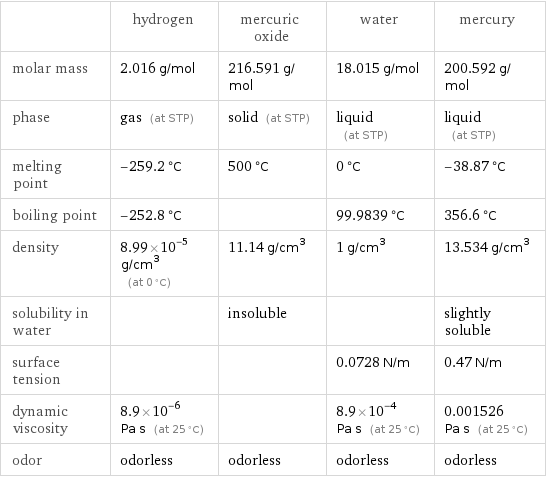
| hydrogen | mercuric oxide | water | mercury molar mass | 2.016 g/mol | 216.591 g/mol | 18.015 g/mol | 200.592 g/mol phase | gas (at STP) | solid (at STP) | liquid (at STP) | liquid (at STP) melting point | -259.2 °C | 500 °C | 0 °C | -38.87 °C boiling point | -252.8 °C | | 99.9839 °C | 356.6 °C density | 8.99×10^-5 g/cm^3 (at 0 °C) | 11.14 g/cm^3 | 1 g/cm^3 | 13.534 g/cm^3 solubility in water | | insoluble | | slightly soluble surface tension | | | 0.0728 N/m | 0.47 N/m dynamic viscosity | 8.9×10^-6 Pa s (at 25 °C) | | 8.9×10^-4 Pa s (at 25 °C) | 0.001526 Pa s (at 25 °C) odor | odorless | odorless | odorless | odorless
Units
